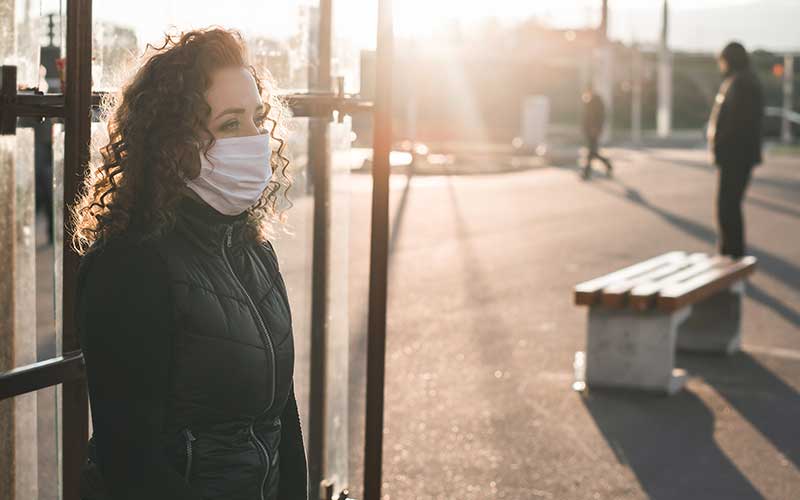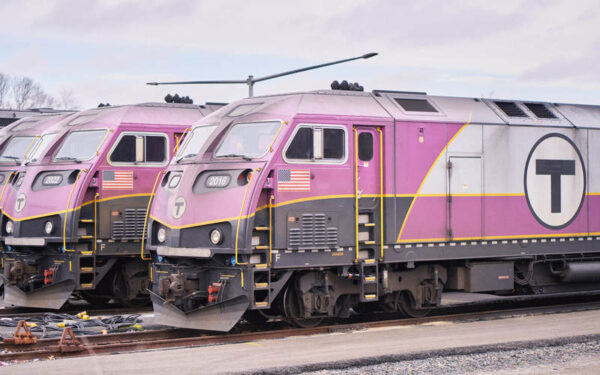
COVID-19's unequal impact on our communities has laid bare stark realities about health, wealth, and housing. In communities with residents dependent on public transportation for getting to work or a grocery store, the risk of infection is higher. Those communities are also more likely to face other stressors that increase their infection risk. Photo: Fox_Ana via Shutterstock
COVID-19’s unequal impact on our communities has laid bare stark realities about health, wealth, and housing. When the pandemic began, the news and social media flooded with images and stories of people retreating indoors. Lives became centered on screens serving as intermediaries between friends, family members, and co-workers.
But that was not the experience for all of our neighbors. Affluent communities found that they could manage their lives more easily indoors and online, safe from exposure. Elsewhere, however, many cannot comply with stay-at-home directives even as the risks of daily life have increased.
In and around Boston, for example, blue-collar workers from places like Chelsea, East Boston, and Lynn still need to board crowded buses and trains. Despite the risk of exposure, they are on their way to jobs considered essential for a metropolitan area on lockdown. Their ability to get to and do these jobs keeps the rest of the Greater Boston area going. And when they return home after their shifts, they’re often unable to self-isolate, which spreads the risk of infection to their families, too.
These communities and others around New England already face health risks beyond exposure to COVID-19. They are also overburdened with environmental hazards, financial stress, and chronic health issues. Is it any wonder then, that these same communities have some of the state’s highest infection and mortality rates from coronavirus?
Such injustices do not develop overnight, nor are they solved quickly. But decision makers and community leaders can take immediate steps to understand and ease the burdens being borne so unequally. And we all can begin planning for a post-COVID-19 reality that does not merely accept business as usual – in which health and economic risks remain serrated along class and racial lines.
Whether You Can Work from Home Depends on Your Zip Code
In Massachusetts and other New England states, we now see that working-class and communities of color are much more likely to be exposed to COVID-19. In Boston, the neighborhoods of East Boston, Mattapan, Roxbury, and Dorchester have seen the city’s highest infection rates. Chelsea has the highest infection rate of any city in the state.
Many workers in these communities are employed in production, manufacturing, maintenance, construction, transportation, or service occupations. A lot of them have either lost their jobs or now serve as de-facto first responders. In these places and others like them, only 40% to 60% of workers are employed in management, sciences, the arts, sales, or office jobs – making it less likely that they can work from home. In contrast, in wealthier and whiter communities such as Brookline, Cambridge, and Arlington, over 80 percent of workers are employed in these roles.
In essence, zip code plays an outsized role in both the risk of infection from coronavirus and the economic harm from containment measures. What’s more, that risk is made even more acute by existing stressors – from financial to environmental to health – that plague these same communities at higher rates than their wealthier neighbors.
Low-income and Communities of Color Bear the Brunt
COVID-19 infection rates and deaths coincide with housing cost burdens, poorer environmental quality, and social vulnerability, as shown in these maps created by the Center for Research on Environmental and Social Stressors in Housing Across the Life Course. The influx of new investment into these neighborhoods has created additional financial stressors. Evictions happen at a much higher rate, and the related stress takes a toll on the physical and mental health of residents.
Research from CLF’s Healthy Neighborhoods Study reinforces the myriad factors that put these neighborhoods on the frontline of the pandemic and its consequences. Most of the individuals surveyed through the Study had financial difficulties before the pandemic and struggled to pay for necessities like food and housing. These problems are now exacerbated by the current mass unemployment and the shuttering of trusted community institutions, such as churches, community centers, and local businesses.
Together, these physical, mental, and social stressors place these residents at higher risk from coronavirus, both in terms of material consequences and elevated stress levels.
A History of Burdens
These risk factors cannot be remedied simply by individuals taking action to protect themselves or their families. As our Healthy Neighborhoods Study has shown – and as the maps of COVID-19 infections bears out – low-income and people of color face community-level stressors resulting from public health inequities and environmental injustices. These stressors result directly from decades of discriminatory housing policy.
Redlining and lending discrimination from the 1940s to 1960s deliberately segregated communities. These federal and local policies prevented non-white households from buying good quality housing in suburban neighborhoods – and denied people of color the opportunities to build wealth that come with homeownership. At the same time, planning boards placed freeways and polluting industrial facilities in urban neighborhoods. That, in turn, lowered property values, drove those who could afford it out of the city, and deteriorated air quality and the health of residents left behind. Decades of disrepair and disinvestment in urban neighborhoods further worsened their environmental quality.
While this blatant housing discrimination was officially stopped in the late 1960s, the impact remains evident today. Low-income households and households of color are more likely to live next to highways and hazardous facilities and less likely to live close to green space and essential services.
As a result, people of color in Massachusetts are exposed to vehicular pollution at concentrations up to 36% higher than white residents, increasing the risk of respiratory and heart disease. The same trends hold elsewhere in New England. For example, Providence, Rhode Island, has one of the highest disparities in air pollution exposure between white and non-white households.
Exposure to poor air quality leads to higher rates of disease and poorer self-reported health. We see this play out in real-time. Research shows that poor air quality and, specifically, long-term exposure to high levels of particulate matter – like pollution from transportation – makes people more susceptible to complications from COVID-19 due to respiratory illness.
Where Do We Go From Here? Recommendations for Decision Makers
Sheltering in place under COVID-19 is not realistic or, often, safe for many communities, including those participating in the Healthy Neighborhoods Study. Residents without stable housing or employment face cumulative risks to their physical and mental health and that of their families, as do those who must rely on public transit to work. Meanwhile, air quality burdens and lack of access to food, open space, and other resources that result from historic segregation further compound these health risks.
While it’s impossible to fix every longstanding injustice immediately, we can shape policies and practices to help protect those communities most affected by COVID-19 right now. With our community partners in the Healthy Neighborhoods Study, we have developed a list of recommendations for the federal government and states to implement, including:
- Ensure that public transportation is safe and operating to accommodate essential workers. Transit authorities should be funded such that essential workers and transit workers can travel safely. Transit should be properly sanitized, while workers themselves should receive protective equipment. Transit authorities should continue to monitor routes and their frequency to prevent crowding.
- In addition to stopping evictions and foreclosures, take measures to provide stable housing and housing cost relief. Provide rental and mortgage relief and suspend payments for households affected by the pandemic. Ensure that households have access to debt relief following the pandemic as detailed by the Healthy Housing Guarantee advanced by City Life Vida Urbana and several community organizations. Provide safe housing for unhoused individuals and additional support for food pantries and mutual aid networks.
- Expand and continue coverage of unemployment and health care benefits. Coverage must include the undocumented, informally employed workers, and gig economy workers. With this, expand access to healthcare for all uninsured individuals.
- Meet communities where they are to disseminate information and resources in multiple languages and communication channels. Public officials must do more to communicate to communities where to go for testing and treatment for COVID-19 and how to access financial resources, including unemployment benefits and rental and mortgage relief. The same follows for immediate needs, such as free meals, household goods, and shelter. Officials should share this information online as well as through community hubs and networks. Trusted community organizations, clinics, and shelters already have a strong understanding of the community and their needs through their ongoing work.
- Mitigate the risks faced by essential workers and compensate them adequately. Mandate that employers provide hazard pay for all essential workers. Standards for workplace safety to avoid the spread of infection must also be required. Ensure that these workers have access to medical care, testing, and treatment.
At a time when we’re all striving to stay safe and do the best we can for our families, no one should have to choose between work, health, and putting food on the table. Yet that is exactly where longstanding disparities have left too many low-income and communities of color. We need to ensure that our local leaders and decision makers respond to the needs of all residents, especially those on the front lines of this crisis. These policies will help and are within reach of our state and local governments.
But they are just a start in creating communities that can be more resilient in the face of challenges to come. In a future blog, we’ll examine the necessary steps to ensure that our communities truly can not just survive but thrive.




